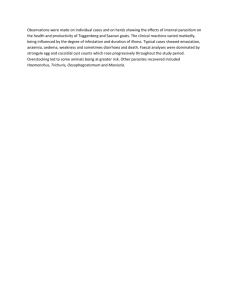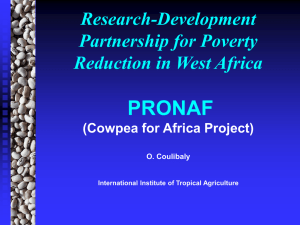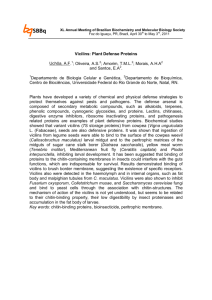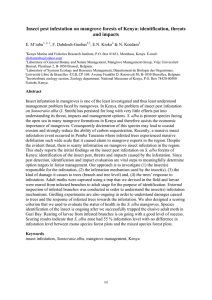Document 14093829
advertisement
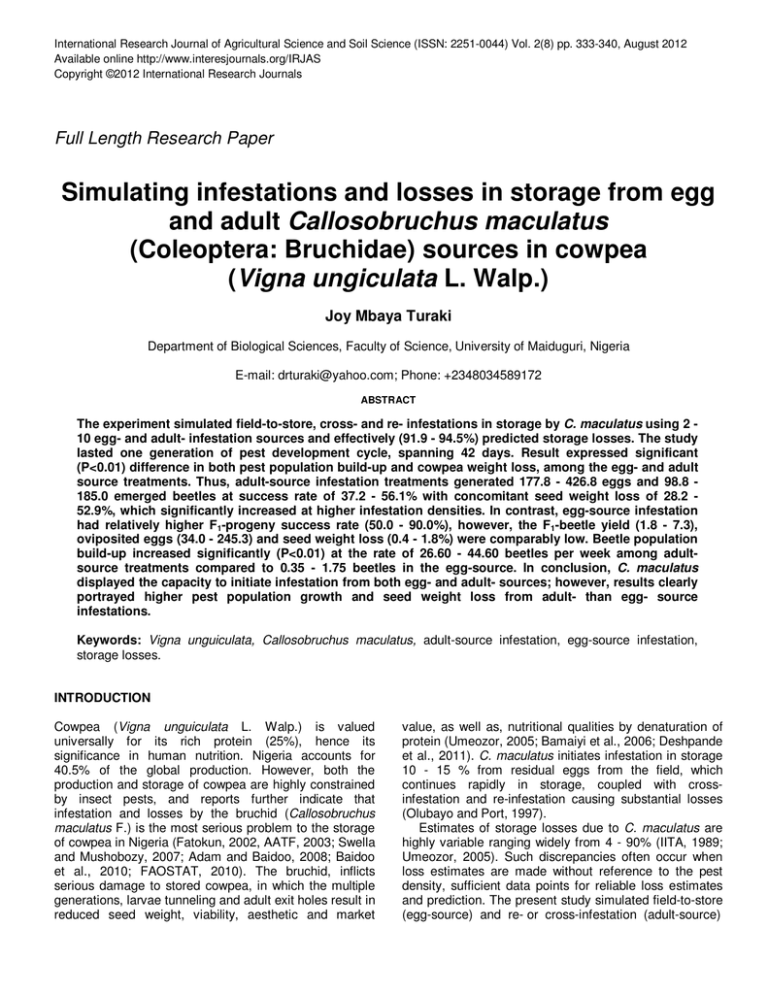
International Research Journal of Agricultural Science and Soil Science (ISSN: 2251-0044) Vol. 2(8) pp. 333-340, August 2012 Available online http://www.interesjournals.org/IRJAS Copyright ©2012 International Research Journals Full Length Research Paper Simulating infestations and losses in storage from egg and adult Callosobruchus maculatus (Coleoptera: Bruchidae) sources in cowpea (Vigna ungiculata L. Walp.) Joy Mbaya Turaki Department of Biological Sciences, Faculty of Science, University of Maiduguri, Nigeria E-mail: drturaki@yahoo.com; Phone: +2348034589172 ABSTRACT The experiment simulated field-to-store, cross- and re- infestations in storage by C. maculatus using 2 10 egg- and adult- infestation sources and effectively (91.9 - 94.5%) predicted storage losses. The study lasted one generation of pest development cycle, spanning 42 days. Result expressed significant (P<0.01) difference in both pest population build-up and cowpea weight loss, among the egg- and adult source treatments. Thus, adult-source infestation treatments generated 177.8 - 426.8 eggs and 98.8 185.0 emerged beetles at success rate of 37.2 - 56.1% with concomitant seed weight loss of 28.2 52.9%, which significantly increased at higher infestation densities. In contrast, egg-source infestation had relatively higher F1-progeny success rate (50.0 - 90.0%), however, the F1-beetle yield (1.8 - 7.3), oviposited eggs (34.0 - 245.3) and seed weight loss (0.4 - 1.8%) were comparably low. Beetle population build-up increased significantly (P<0.01) at the rate of 26.60 - 44.60 beetles per week among adultsource treatments compared to 0.35 - 1.75 beetles in the egg-source. In conclusion, C. maculatus displayed the capacity to initiate infestation from both egg- and adult- sources; however, results clearly portrayed higher pest population growth and seed weight loss from adult- than egg- source infestations. Keywords: Vigna unguiculata, Callosobruchus maculatus, adult-source infestation, egg-source infestation, storage losses. INTRODUCTION Cowpea (Vigna unguiculata L. Walp.) is valued universally for its rich protein (25%), hence its significance in human nutrition. Nigeria accounts for 40.5% of the global production. However, both the production and storage of cowpea are highly constrained by insect pests, and reports further indicate that infestation and losses by the bruchid (Callosobruchus maculatus F.) is the most serious problem to the storage of cowpea in Nigeria (Fatokun, 2002, AATF, 2003; Swella and Mushobozy, 2007; Adam and Baidoo, 2008; Baidoo et al., 2010; FAOSTAT, 2010). The bruchid, inflicts serious damage to stored cowpea, in which the multiple generations, larvae tunneling and adult exit holes result in reduced seed weight, viability, aesthetic and market value, as well as, nutritional qualities by denaturation of protein (Umeozor, 2005; Bamaiyi et al., 2006; Deshpande et al., 2011). C. maculatus initiates infestation in storage 10 - 15 % from residual eggs from the field, which continues rapidly in storage, coupled with crossinfestation and re-infestation causing substantial losses (Olubayo and Port, 1997). Estimates of storage losses due to C. maculatus are highly variable ranging widely from 4 - 90% (IITA, 1989; Umeozor, 2005). Such discrepancies often occur when loss estimates are made without reference to the pest density, sufficient data points for reliable loss estimates and prediction. The present study simulated field-to-store (egg-source) and re- or cross-infestation (adult-source) 334 Int. Res. J. Agric. Sci. Soil Sci. as tools for generating different infestation levels to infer storage losses by C. maculatus. MATERIALS AND METHODS Culture Methods Stock cultures of C. maculatus were maintained on cowpea (cv: Borno brown) in University of Maiduguri, Biological Sciences Laboratory. A thermohydrograph was used to monitor temperature and relative humidity in the laboratory. Ambient temperature and relative humidity in the laboratory were 33.6±0.210C and 35.8±0.13% RH. Culture method described by Buahin and Turaki (1999) was used in which seeds with adults ready to emerge were sorted into a kilner jar. Newly emerged adults were then sieved (2 mm mesh), allowed to mate for 1 h, sexed and the pre-mated females used for the adult-source test. Same batch of pre-mated females were used to raise the egg-source treatments, meant to harmonize the two sources. Experimental Design and Procedure Randomized Complete Block Design was employed for the experiment, in which egg- and adult- infestation sources were meant to simulate field-to-store, cross- and re-infestation in storage by eggs and adult C. maculatus, respectively. Thus, treatments consisted of 2, 4, 6, 8 and 10 egg-laden seeds and similar batches of pre-mated females for egg-source and adult-source, respectively. Treatments were replicated four times and then randomly assigned to kilner jars containing 100 g of clean seeds, screened with muslin cloth and secured rubber band to prevent escape. Data Collection and Analysis Egg count and adult census were taken at bi-weekly interval spanning one generation of pest development cycle of 42 days. Actual loss (%) was calculated as described by Deshpande et al. (2011), thus: U(Nd) – D(Nu) Actual weight loss (%) = _____________ U (Nu + Nd) RESULTS Results of the study both expressed significant (P<0.01) difference in infestation levels among adult-source and egg-source treatments (Figures 1 and 2). Figure 1 compares oviposition and adult emergence among the adult-source infestation treatments, in which both egg and beetle counts were invariably significantly (P<0.01) higher at higher infestation densities of 8 and 10 than lower infestation with 2 - 6 that were statistically at par. Oviposition ranged from 119.3 - 299.8, 149.0 - 402.3, and 177.8 - 426.8 eggs, at 7, 14 and 21 DAI, respectively (Figure 1a), while emerged adults ranged from 44.8 95.8, 80 - 143.3 and 98.8 - 185.0 beetles at 28, 35 and 42 DAI, respectively (Figure 1b). Similarly, both population of F1-adult that emerged in the egg-source treatments and eggs laid increased significantly with increase in egg-density, thus the highest emergence consistently occurred at 10-, followed by 8- then 6-egg density than at lower egg-densities of 2 and 4 that were at par. Mean number of F1-progeny ranged from 1.0 - 3.8, 1.5 - 7.3 and 1.8 - 7.3 at 7, 14 and 21 DAI, respectively (Figure 2b) and the mean number of eggs laid ranged from 19.3 - 186.0, 25.5 - 218.0 and 34.0 - 245.3 at 28, 35 and 42 DAI, respectively (Figure 2b). Result of the regression for adult-source infestation indicated highly significant (P<0.01) rate of increase in oviposition (r2 = 0.8883 – 0.9999) and beetle population 2 (r = 0.9423 - 0.9986) over time (Figure 3). The regression coefficient showed oviposition rate of 27.50 63.50 eggs and beetle population growth rate of 26.60 44.60 beetles per week. In the egg-source infestation, the weekly rate of beetle population growth increased significantly (P<0.01) at 0.35 – 1.75 beetles and oviposition at 7.00 - 50.65 eggs per week (Figure 4). Actual loss in grain weight varied significantly from 28.2 - 52.9% in the adult-source infestation, in contrasts to 0.4 - 1.8% in the egg-source treatments that were statistically at par (Figure 5a). These losses occurred at the rate of 5.69% and 0.13% in the adult source and eggsource, respectively from each successive increase in infestation level (Figure 5b). Figure 6 expressed that the egg- and adult- sources had effectively simulated field-tostore, cross- and re- infestations in storage by C. maculatus in predicting losses by 91.9% and 94.5%, respectively. x 100% Where, U - weight of undamaged seeds, Nd - number of damaged seeds, D - weight of damaged, Nu - Number of undamaged seeds. Data obtained were analyzed using the analytical software, Statistix 8.0, while charts were drawn using Microsoft Excel, 2003. DISCUSSION C. maculatus is a serious constraint to cowpea storage that has displayed the capacity to initiate infestation from as low as 2 - 10 egg- and adult- sources. Both egg and beetle count significantly increased with infestation level, irrespective of the source of infestation. However, results clearly portrayed higher population build-up from adult- Turaki et al. 335 Figure 1. Comparison of a) oviposition and b) F1-adult emergence among the adult-source infestation treatments source than egg-source; F1-beetle yield from one generation of the adult-source infestation ranged from 98.8 - 185.0, in contrast, to lower beetle yield (1.8 - 7.3) from egg-source. This clearly suggests that cross- or reinfestations by adults might trigger higher population growth and consequently losses than field-to-store infestation from eggs. However, in a related study on egg-source infestations, Baidoo et al. (2010) reported higher population build-up range (1.7 - 136.7 beetles), as harvest was delayed by 20 days. The difference is attri- 336 Int. Res. J. Agric. Sci. Soil Sci. Figure 2. Comparison of a) F1-adult progeny and b) oviposition among the egg-source infestation treatments butable to the number of generations, which lasted one generation (42 days) in the present study compared to two (80 days) in the earlier report. However, the results indicted 177.8 - 426.8 and 34.0 - 245.3 eggs, oviposited by the emerged F1-beetles with success rates of 37.2 56.1% and 50.0 - 90.0% for adult-source and egg-source treatments, respectively, indicative that such pest buildup could be attained over two generations. The present study also revealed variation in weight losses stemming from different densities of adult- and egg- source infestations. The adult-source inflicted higher losses of 28.2 - 52.9% compared to the egg-source that Turaki et al. 337 Figure 3. Relative rates of a) oviposition and b) F1-adult emergence among adultsource treatments over three weeks period registered losses of 0.4 - 1.8%. However, Deshpande et al. (2011) recorded lower weight losses (3.14 - 27.02%), where as Baidoo et al. (2010) obtained higher losses (8.7 -12.5%) from egg infestation, than was obtained in the present study, probably due to differences in genotype susceptibility and the test period, which according to Adam and Baidoo (2008) are important loss indices. The cowpea variety used in the present study has suscep- 338 Int. Res. J. Agric. Sci. Soil Sci. Figure 4. Relative rates of a) F1-adult emergence and b) oviposition among egg-source treatments over three weeks period tibility index of 4.0 (Turaki and Buahin, 1999) while pest activity lasted 42 days. Although, Umeozor (2005) construed higher losses in actual storage (0.026g per beetle) than in laboratory experiments (0.016 g per beetle), the present result of the regression expressed significant increase in beetle population build-up of 26.60 - 44.60 beetles per week among adult-source treatments compared to 0.35 - 1.75 beetles in the egg-source. The implication of the present findings is that these weight losses would further impose additional economic burden Turaki et al. 339 Figure 5. Simulated of the a) fecundity of C. maculatus and b) weight loss in cowpea from different sources and levels of infestation to production cost on farmers. In conclusion, the efficacy of the present experiment in predicting storage losses due to the simulated field-to-store, cross- and reinfestations was 91.9% and 94.5%, respectively; attesting to higher infestation and losses from adult source (crossand re- infestation) than egg-source (field-to-store infestation). REFERENCES AATF (African Agricultural Technology Foundation) (2003). Report of Small Group Meeting on Constraints to Cowpea Production and Utilization in Sub-saharan Africa, 10 - 11 July, 2003. AATF Headquaters, Nairobi, Kenya. 59pp. Adam JI, Baidoo PK (2008). Susceptibility of five cowpea (Vigna unguiculata) varieties to attack by Callosobruchus maculatus (Fab.) [Coleoptera: Bruchidae]. J. Ghana Sci. Assoc. 10(2): 85 - 92. 340 Int. Res. J. Agric. Sci. Soil Sci. Baidoo PK, Mochiah MB, Owusu-Akyaw M (2010). The effect of time of harvest on the damage caused by the cowpea weevil Callosobruchus maculatus (Fab.) (Coleoptera: Bruchidae). J. Stored Prod. Postharvest Res. 1(3): 24 - 28. Bamaiyi LJ, Onu I, Amatobi CI, Dike MC (2006). Effects of Callosobruchus maculatus infestation on nutritional loss on stored cowpea grains. Ach. Phytopathol. and Plant Prot. 39 (2): 119 -127. Buahin GKA, Turaki JM (1999). Studies on oviposition behaviours of cowpea bruchid, Callosobruchus maculatus (F.) on seeds of cowpea, Vigna unguiculata (L.) Walp. Biosci. Res. Comm. 11(3): 235 - 240. Deshpande VK, Makanur B, Deshpande SK, Adiger S, Salimath PM (2011). Quantitative and qualitative losses caused by Callosobruchus maculatus in cowpea during seed storage. Plant Achives. 11(2): 723 731. FAOSTAT (Food and Agricultural Organization) (2010). FAO Statistical Yearbook, 2012. Fatokun CA (2002). Challenges and Opportunities for Enhancing Sustainable Cowpea Production. International Institute for Tropical Agriculture, IITA. 433pp. IITA (International Institute of Tropical Agriculture) (1989). Annual Report 1988/89. Ibadan, Nigeria. Olubayo FM, Port GR (1997). The efficacy of harvest time modification and intercropping as methods of reducing the field infestation of cowpeas by storage bruchid in Kenya. J. Stored Prod. Res. 33(4): 271 - 276. Swella GB, Mushobozy DMK (2007). Evaluation of the efficacy of protectants against cowpea bruchids (Callosobruchus maculatus (F.)) on cowpea seeds (Vigna unguiculata (L). Walp.). Plant Protect. Sci. 43: 68 - 72. Turaki JM, Buahin GKA (1999). Studies on oviposition and development of cowpea bruchid, Callosobruchus maculatus (F.) on different varieties of cowpea, Vigna unguiculata (L.) Walp. Biosci. Res. Comm. 11(3): 227 - 233.. Umeozor OC (2005). Effect of the infection of Callosobruchus maculatus (Fab.) on the weight loss of stored cowpea (Vigna unguiculata (L.) Walp. J. Appl. Sci. Environ. Mgt. 9(1): 169 -172.

